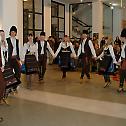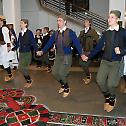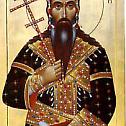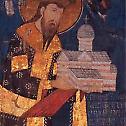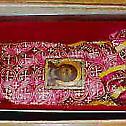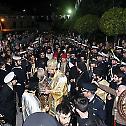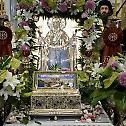In order to avoid the marriage which his parents had intended for him, he secretly left home. He spent all his life wandering: he was in Constantinople, Rome, Corinth, and he lived as an ascetic on Olympus for a while. Saint Gregory preached the Word of God everywhere, denouncing the Iconoclast heresy, strengthening the faith and fortitude of the Orthodox, whom the heretics in those times oppressed, tortured and imprisoned.
Culture
Kolo - traditional folk dance
8. December 2017 - 9:24Inscribed in 2017 (12.COM) on the Representative List of the Intangible Cultural Heritage of Humanity
Kolo is a traditional, collective folk dance performed by dancers who are interlinked to form a chain, usually moving in a circular line holding hands with their arms down. It is performed to the accompaniment of music at private and public gatherings and involves all members of the local community. Cultural-artistic societies and folk dance troupes are also important bearers and practitioners of the element. Kolo has an important integrative social function, fostering collective identities at different levels in the communities. It is a symbol of national identity and bears the hallmark of local and regional communal identities.
Venerable Gregory Decapolite
3. December 2017 - 23:31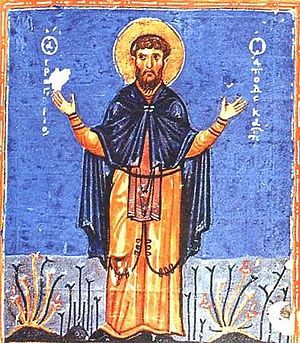 Commemorated on November 20
Commemorated on November 20
Saint Gregory the Decapolite was born in the Isaurian city of Decapolis (ten cities) in the eighth century. From his childhood he loved the temple of God and church services. He read the Holy Scripture constantly and with reverence.
The Life of St. King Stephen of Decani
24. November 2017 - 15:22St. King Stephen of Decani is one of the best known Saints of the
Serbian Orthodox Church. Through his holy and incorruptible relics God has performed numerous miracles.
Today, as the Serbian people suffer through another turbulent chapter in their history, they would do well to bring to mind the exemplary character of their martyred King Stephen Uros III (Decanski).
Waves of faithful Greeks continue to venerate Cincture of Theotokos
15. November 2017 - 13:42Tens of thousands of residents of the Greek capital were blessed to be able to venerate the Cincture of the Most Holy Theotokos which had been delivered to the suburb of Neo Ionia on November 3 by a delegation from Vatopedi Monastery, headed by Abbot Ephraim. The holy relic remained until yesterday for veneration in the Church of the Holy Unmercenaries.
Stefan Uros II Milutin (1282-1321)
12. November 2017 - 11:14 The long reign of one of the most illustrious and powerful medieval Serbian figures - the "Holy King Uros", (Milutin by given vernacular name; pr. mee-LOO-tin) - marked the elevation of Serbia to a dominant Balkan position, and saw cultural and economic prosperity and advances along many lines.
The long reign of one of the most illustrious and powerful medieval Serbian figures - the "Holy King Uros", (Milutin by given vernacular name; pr. mee-LOO-tin) - marked the elevation of Serbia to a dominant Balkan position, and saw cultural and economic prosperity and advances along many lines.
The first 17 years or so of the new king's rule witnessed considerable international activity - through much warfare and some diplomacy - most of it south and east against the ailing Byzantine state, some against decentralized Bulgarian interests in the northeast. Much of that was brought to a close with the Serbo-Byzantine peace treaty of 1299, which recognized the new realities of Serb expansion into the mostly South Slavic ethnic space in Macedonia. The agreement was sealed by a high-level royal marriage between the king and emperor Andronikos' minor daughter Simonida (Simonis), and assured a generally cordial relationship between the two courts for the rest of Milutin's reign. Helplessly caught in the middle of court diplomacy was the unhappy young princess; her unlikely moral vindication ultimately came through her fine portrait, well preserved and juxtaposed to the much older king at Gracanica monastery: her firm forceful gaze, having mostly defied visible Ottoman attempts at vandalism and eradication, remained for generations a famous reminder and symbol - as much of defiance as the transcendental triumph of real values over time.
Why This Serbian Temple Is Eastern Europe’s Sagrada Família
7. November 2017 - 14:21 On the descent into Belgrade, the St. Sava Temple protrudes from the top of Vračar Hill like the city’s crowning jewel. But its grand white marble and granite facade topped with copper domes contains a secret: The second largest Orthodox temple in the world is largely incomplete inside. With a story that rivals that of Barcelona’s famously incomplete Sagrada Família, Belgrade’s St. Sava Temple is an eternal work-in-progress—one that’s existed in various stages of creation for more than 100 years.
On the descent into Belgrade, the St. Sava Temple protrudes from the top of Vračar Hill like the city’s crowning jewel. But its grand white marble and granite facade topped with copper domes contains a secret: The second largest Orthodox temple in the world is largely incomplete inside. With a story that rivals that of Barcelona’s famously incomplete Sagrada Família, Belgrade’s St. Sava Temple is an eternal work-in-progress—one that’s existed in various stages of creation for more than 100 years.


